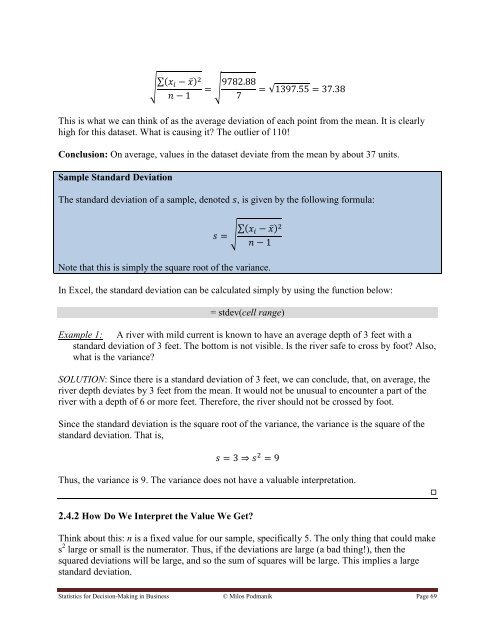Statistics for Decision- Making in Business - Maricopa Community ...
Statistics for Decision- Making in Business - Maricopa Community ...
Statistics for Decision- Making in Business - Maricopa Community ...
You also want an ePaper? Increase the reach of your titles
YUMPU automatically turns print PDFs into web optimized ePapers that Google loves.
√ ∑( ̅) √ √<br />
This is what we can th<strong>in</strong>k of as the average deviation of each po<strong>in</strong>t from the mean. It is clearly<br />
high <strong>for</strong> this dataset. What is caus<strong>in</strong>g it The outlier of 110!<br />
Conclusion: On average, values <strong>in</strong> the dataset deviate from the mean by about 37 units.<br />
Sample Standard Deviation<br />
The standard deviation of a sample, denoted , is given by the follow<strong>in</strong>g <strong>for</strong>mula:<br />
∑( ̅)<br />
√<br />
Note that this is simply the square root of the variance.<br />
In Excel, the standard deviation can be calculated simply by us<strong>in</strong>g the function below:<br />
= stdev(cell range)<br />
Example 1: A river with mild current is known to have an average depth of 3 feet with a<br />
standard deviation of 3 feet. The bottom is not visible. Is the river safe to cross by foot Also,<br />
what is the variance<br />
SOLUTION: S<strong>in</strong>ce there is a standard deviation of 3 feet, we can conclude, that, on average, the<br />
river depth deviates by 3 feet from the mean. It would not be unusual to encounter a part of the<br />
river with a depth of 6 or more feet. There<strong>for</strong>e, the river should not be crossed by foot.<br />
S<strong>in</strong>ce the standard deviation is the square root of the variance, the variance is the square of the<br />
standard deviation. That is,<br />
Thus, the variance is 9. The variance does not have a valuable <strong>in</strong>terpretation.<br />
2.4.2 How Do We Interpret the Value We Get<br />
Th<strong>in</strong>k about this: n is a fixed value <strong>for</strong> our sample, specifically 5. The only th<strong>in</strong>g that could make<br />
s 2 large or small is the numerator. Thus, if the deviations are large (a bad th<strong>in</strong>g!), then the<br />
squared deviations will be large, and so the sum of squares will be large. This implies a large<br />
standard deviation.<br />
<strong>Statistics</strong> <strong>for</strong> <strong>Decision</strong>-<strong>Mak<strong>in</strong>g</strong> <strong>in</strong> Bus<strong>in</strong>ess © Milos Podmanik Page 69
















